67-69 Camaro Model Information
©1998-2023, Camaro Research Group
Edited by Kurt Sonen
Version: Sunday, 26-Mar-2023 23:30:31 EDT
-
Differences between the 1967 and 1968 Camaros
-
1969 Camaro Design Changes
-
Rally Sport (RS) Camaros
-
Super Sport (SS) Camaros
-
First-generation Camaro Z-28's
-
L30/M20 and LM1 models
CRG Research Report:
1967-68 L30/M20
and
1969 LM1
-
Camaro Pace Cars
CRG Research Report:
1969 Pace Cars and Z10's
-
COPO Camaros
CRG Research Report:
1969 COPO 427s - ZL1 and L72
-
ID'ing first-generation high-performance models
-
Dealer Modified Camaros - Yenko, Baldwin-Motion, Nickey, or ...
Differences between the 1967 and 1968 Camaros
The 1967 model had the same body lines as the 1968 model. There were a few
design changes in 1968. The vent windows were eliminated. To replace that
airflow, below-dash air vents (Astro-Ventilation) were added to the interior.
Sidemarker lights were added to the front fenders and ther rear quarters,
a mandate for all 1968 vehicles by the NTSA.
1967 Camaro
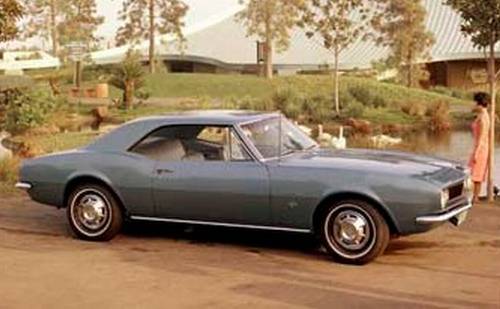
|
|
1968 Camaro
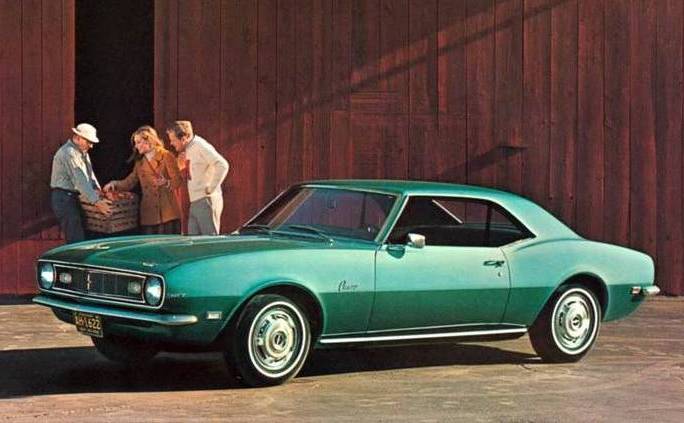
|
|
There were several other 1968 model changes, but here are some of the more
apparent changes:
- Engine size emblems were moved to the front of the fenders.
- The tail lights and the standard (non-RS) grille were restyled.
- The door mirrors were changed from
circular to rectangular in shape.
- Additional padding was added to the dash, A-pillars, and the
armrests.
- Much of the bright interior trim was changed to a brushed
finish to reduce driver glare.
- The console, if ordered, was a new totally restyled model.
- The standard short rear-bumper guards that were used
in both '67 and '69 were not used in 1968. They
were canceled immediately prior to start of 1968 production. (And
though they can be installed on the bumper of a '68, they are
not correct.)
- A woodgrain (simulated walnut) dash center panel molding
was a new finish.
1969 Camaro Design Changes
While the 1969 hood, roof, and decklid did not change, the
body lines were significantly modified at the nose, fenders, quarters,
and tailpan, giving the Camaro a more streamlined look. A molded body
streak extended from the rear of each wheel opening, adding to the
effect.
1969 Camaro RS convertible
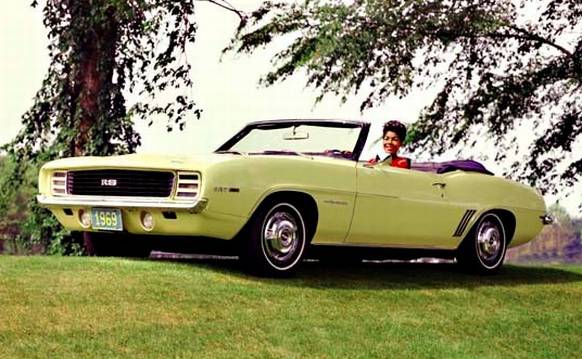
|
|
1969 Camaro SS
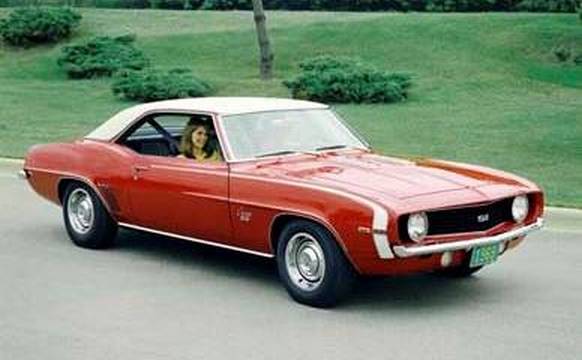
|
|
Other 1969 model changes:
- Tail light bezels were changed to a triple-lens styling.
- The angle of the standard grille was increased to make it more pointed
and the size of the grille openings was increased. The Rally Sport grille
was redesigned.
- A rear quarterpanels side "louver" impression was included
in the sheetmetal in front of the rear wheels (this impression was
overlayed with chrome trim as part of the style trim (Z21/Z22) option).
- The dash was redesigned with square gauges versus the round gauges in 67/68.
- The interior simulated woodgrain pattern was changed from walnut (68)
to rosewood (69).
- The ignition switch moved from the dash to the steering column.
- Headrests became a standard feature.
Major option packages
The Camaro could be ordered in either coupe or convertible models with either
the base 230ci L6 or the base 327ci (307ci for the later part of 69) V8 engine.
There were several optional engines
available, along with a slew of
interior, exterior, and drivetrain options.
The following summarizes the Rally Sport appearance option and the major performance
(L30/LM1, SS, Z28, and COPO) options that were available in 67-69.
Rally Sport (RS) Camaros
The Rally Sport (RS) option was an appearance package that included hideaway
headlights, backup lights under the rear bumper, and special exterior trim. It
was available in combination with any other option, including Z28 or SS
(thus referred to as a RS/Z28 or a RS/SS) or L6 engines.
1967 Camaro RS/SS
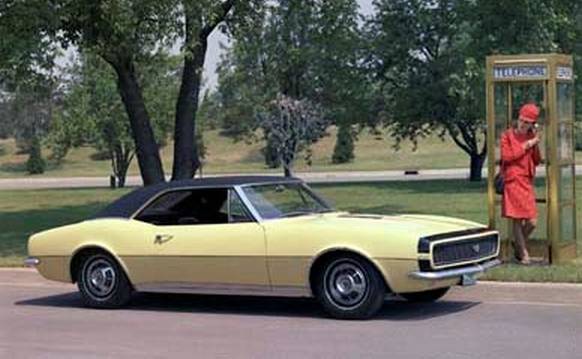
|
|
1968 Camaro RS
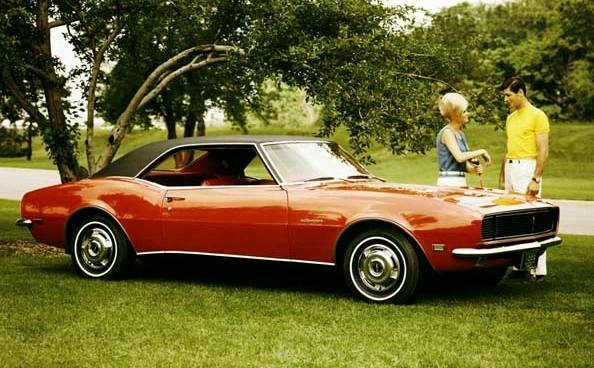
|
|
1969 Camaro RS grille
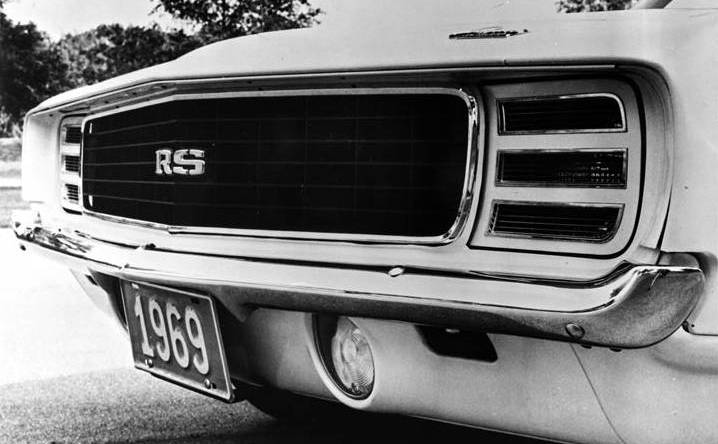
|
|
1969 Camaro RS convertible
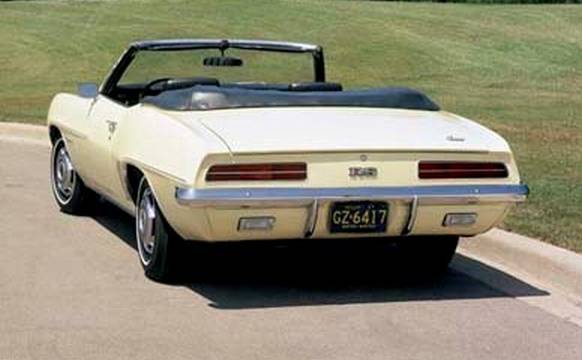
|
|
Super Sport (SS) Camaros
The Super Sport (SS) was a performance option that included upgraded suspension,
higher-performance engine, louvered SS hood, and SS striping and badging.
The base engine for a 67-69 SS was the 350. For 67, the 350 engine was a
Camaro exclusive and was rated at 295 hp; it was not available in other carlines
until 68. The 68 SS350 kept the 295 hp rating but for 69 it was rated at 300 hp.
Several 396 engines were optional: the L35/325hp, the 68-69 L34/350hp, and the L78/375hp.
The L89 aluminum head option was also available on the L78 in 1968 and 1969.
1967 Camaro SS
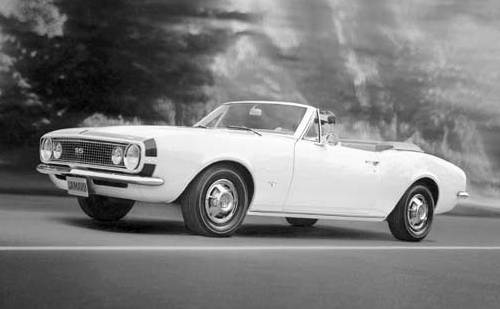
|
|
1969 Camaro SS

|
|
First-generation Camaro Z28
The Z28 option was created to compete with the Mustang in the Trans-Am road-racing
series. All first-generation Z28's were coupes with a 302ci/290HP V8 engine (to
keep within the 305ci maximum for the Trans-Am series), a
4-speed manual Muncie transmission, and 12-bolt rear axle.
The 290 hp engine power rating was conservative, and in racing
trim made in excess of 400HP.
Front and rear springs were specially matched, and the package included
larger 15-inch wheels and rear bumper guards. Power front disc brakes
were required but priced separately. Positraction was recommended but
not required. Gauges and spoilers were optional with the 67-69 Z28
until April/May 69 when a tachometer became a required option and
spoilers became part of the package.
The Z28 was not available with air conditioning, automatic
transmission, or in the convertible body style, although one 1968 Z-28
convertible was built via special order for a GM executive. That car
still exists today.
The first year, Z28 had no external badging at all to
distinguish it from a base L6-engined car, just the stripes on the hood
and decklid. In 1968, a 302
engine emblem was added to the fenders, but in March of 68, the
fender engine emblem was replaced with a "Z/28" emblem. In 1969, there
were Z/28 emblems all over the car - grille, fenders, tailpan - and 302
emblems on the optional cowl hood.
In 1967 and early 1968 (up to mid-January 1968), a cowl plenum air cleaner and/or
headers were available as part of RPO Z28.
The cowl plenum air cleaner and the plastic duct were placed in separate
boxes in the trunk. If headers were ordered, they were in the trunk as
well, along with the trim rings and hub caps for the rally wheels,
which made for a pretty full trunk, to say the least!
For 69, neither the cowl plenum option nor the header option was available,
but in the middle of the model year, the cowl hood
became available as did the JL8 four-wheel disc brakes.
1967 Camaro RS/Z28
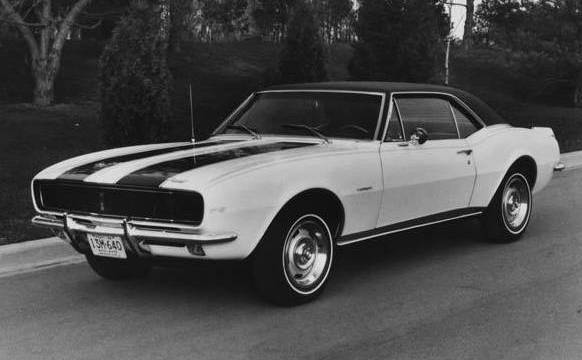
|
|
1969 Camaro Z28
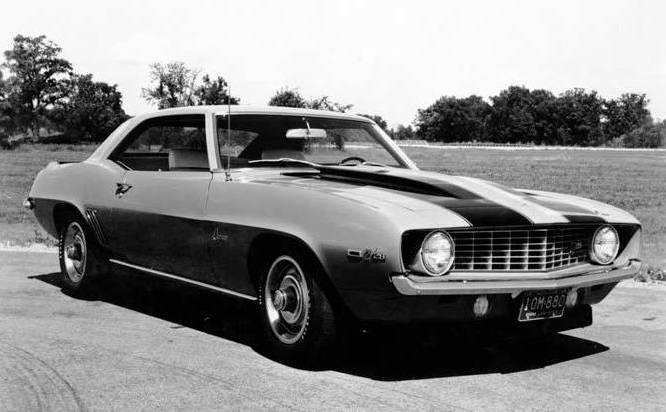
|
|
L30/M20 and LM1 models
The 67-68 L30/M20 (327/275hp engine with 4 speed transmission)
and the 69 LM1 (350/255hp) were not SS or Z28 models, only optional
powertrains over the standard 327 (or 307 in later 69). But both powertrains
received upgraded drivetains: 12 bolt axles and (for the LM1 ordered
with a 4 speed) Muncie transmissions. Since they have one of
the key performance discriminators, the 12 bolt axle, they are often
confused as / converted to SS models.
Original documentation and/or the correct engine code, if present,
is the most reliable identification tool for either model. But there
are some key features to check:
The 67-68 L30/M20 was notable for its use of the cast-iron Saginaw
4-speed, whereas the SS350 used the aluminum-cased Muncie 4-speed
transmission. Related to this, the Saginaw transmission speedometer
cable exited the case on the side opposite
the Muncie, and therefore pierced the firewall on the drivers side of
the steering column. The Muncie speedometer cable passes through the
firewall on the passenger side of the steering column.
For more details on the L30/M20, see the L30/M20 Research Report.
The 1969 LM1 350 can be more difficult to ascertain, since this model
shared many of the same features as the SS350, including two fuel lines,
a 12-bolt axle and, if ordered with a 4-speed, a Muncie transmission.
The SS350 package included disc brakes and dual exhausts. Lack of
either of these features means it originally was a LM1, but, since
both were optional on the LM1, the presence of them is inconclusive.
For more details on the LM1, see the LM1 Research Report.
67 and 69 Camaro Pace Cars (and Z10's)
In both 1967 and 1969, the Camaro was chosen as the Pace Car for the
famous Indy 500 car race. In both years, two Camaros were special-built
to serve as the actual Pace Car for the race (the second was a back-up).
There were a number of other Pace Cars replicas that were used in the festival parade
and by VIP and visiting press at the race. Along with the two literal Pace Cars and
the other Pace Cars in attendance at the race, Chevy offered Pace Car replicas to
dealers for sale to the public. Pace Cars, festival cars, and replicas
were always RS/SS convertible Camaros, with either 350ci or 396ci engines.
In '67, the color scheme was a white Camaro with blue 'bumble bee' stripe
(around the nose), blue deluxe interior, and a white convertible top.
The trim tag will indicate either a O-1 or C-1 paint color, a 732-Z
interior, and a 4P, 4N, or 4K trim tag code.
1967 Camaro Pace Car
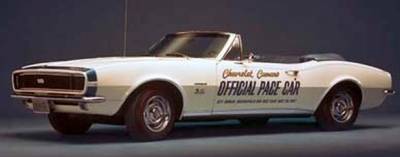
|
|
1969 Camaro Pace Car and Z10
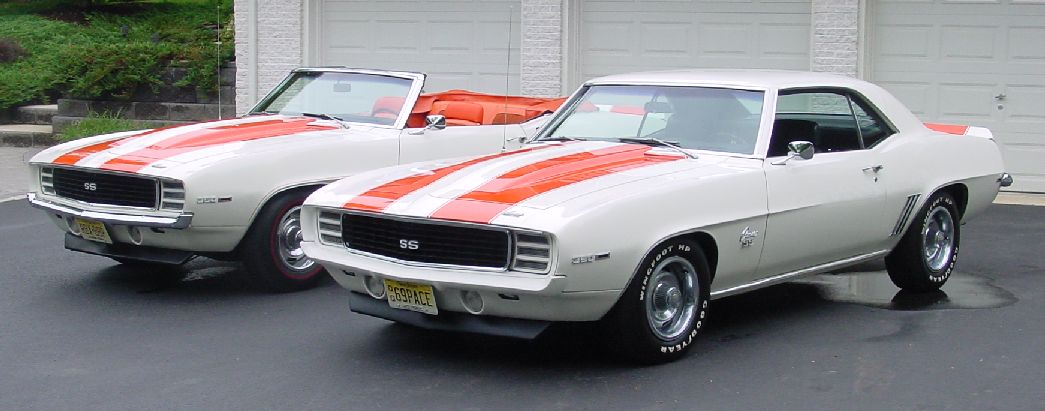
|
|
In '69, the Indy 500 pace car was a white RS/SS with Hugger Orange Z-28-style
stripes, cowl-induction hood, special Hugger Orange interior, and a white
convertible top. The RPO for the 1969 Pace Car replica was Z11 and on
Norwood-built cars, this code is on the cowl tag. Los Angeles-built
cars do not have a special code on the cowl tag, but have the unique
build combination of 50-A exterior and 720 interior codes.
For more details on the 1969 Pace Cars, see the 1969 Pace Car and Z10
Research Report.
There were a limited number of white RS/SS coupes built via the option code Z10
that received the pace car style orange Z28 striping, essentially coupe versions
of the pace car. This was a regional promotion for certain southwestern states.
While the Z10 was similar
to the Z11 Pace Car replica, any color interior could be ordered.
There are no production records but between 450 to 500 of the Z10 cars were built
at the Norwood plant between 3rd week of April (04C) and 1st week of May (05A). All
Z10 cars have a Z10 code on the cowl tag.
COPO Camaros
COPO stands for Central Office Production Order. This is the process used by Chevrolet
(and other divisions of GM) for internal orders for limited production of non-standard
cars. The COPO process was used most often for police vehicles and trucks modified for
specific applications and doesn't necessarily indicate a high-performance
vehicle. But in 68 and 69, the process was used to order high-performance
Camaros that were otherwise not available from the factory.
1968 COPO 9737
The use of the COPO system for high-performance Camaros was pioneered by Don Yenko in 1968.
COPO 9737 was exclusive to Yenko in 68 and included a L78 396 (with a unique MV engine code),
a larger front swaybar, and a 140 MPH speedo. It was not ordered in combination with any
other COPO in 68. Yenko swapped 427 shortblocks into most these cars and sold them as 1968
Yenko 427 cars.
1969 COPOs
For 1969, two COPO versions were built. The ZL-1 used an aluminum 427 block and only 69
of these cars were built. The cast iron version of the 427ci/425hp engine (L72) was
the other. Most options were available on either COPO, with the notable exceptions
of air conditioning (both were solid lifter engines), JL8 disc brakes
(not available with the COPO BE axle), and convertible.
COPO 9560
1969 Camaro ZL1
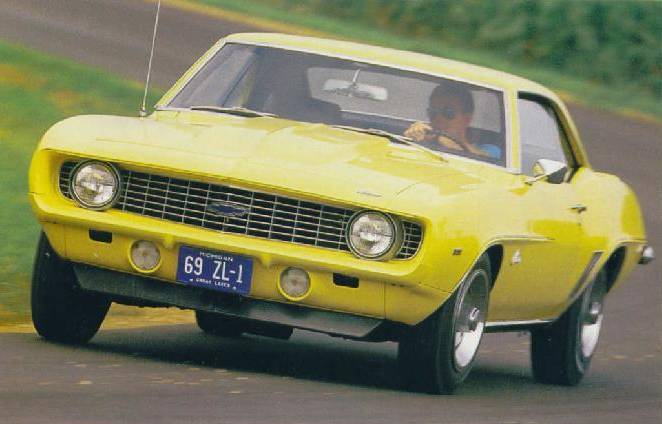
|
COPO 9560 Camaros came from the factory with the ZL-1 aluminum 427ci
engine, a HD 4.10 ratio 12-bolt rear-end, HD radiator, cowl induction,
special springs, and transistorized ignition. It could be had as
either an automatic or a 4-speed manual. Additional options could be ordered.
Originally, the plan was to have 50 cars built
and shipped to Fred Gibb Chevrolet (dealer/racer). Other dealers got
wind of the order and the total build ended up being 69 cars. The
original order of 50 was built identically except for exterior paint
and transmission. In the supplemental 19 units, there were two
Rally Sport cars and two that also had COPO 9737.
Here is a complete list of the
options ordered with each of the sixty-nine COPO 9560 vehicles.
The COPO 9560 option added $4160 to the price of the car and made them
nearly unsellable, with a list price in excess of $7300. Some of the
original engines were pulled and a cast-iron big block installed, with
the pulled ZL-1's being sold as crate engines for use in racecars.
There were ~90 ZL-1 engines produced in '68/'69. 69 of the 90 went
into Camaros, 2 went into Corvettes, 2 went into COPO 9567 prototypes,
and the rest (~17) were sold as crate engines. There were many more blocks
eventually sold as service parts.
Despite lower factory quoted numbers, the ZL-1 factory dyno shows it
produces ~575hp at ~6400rpm and ~515 ft-lbs torque at ~5000rpm, in
stock form with manifolds.
COPO 9561
COPO 9561 was basically the same as the 9560 except it got an all-iron 427/425hp (L72)
without transistorized ignition. Many dealers found out about this COPO and ordered
it. Records were not kept on these as they were for the ZL-1s, but it is believed
that 997 iron 427 cars were built in 1969. As opposed to the ZL-1, the L72 was a
bargain at under $500, whereas a SS396 L78 was over $600.
COPO 9737
The 1969 COPO 9737 required ordering COPO 9560 or 9561 (aluminum or cast-iron 427ci
engine), hence creating a so-called "double COPO". 9737 was labeled "sports car
conversion" and it added a 140 MPH speedometer, a
13/16-inch diameter stabilizer shaft (increased from the 11/16-inch diameter
standard bar), and E70x15 Goodyear Wide Tread GT tires on 15-inch rally wheels.
COPO 9737 cars built after May 1969 also received U16 - factory tachometer
with a center gas gauge. In 1969, COPO 9737 was ordered by Yenko and also by other
dealers, notably Berger, Jack Douglass, and Emmert Chevrolet.
COPO 9567
As soon as the dealers realized the price of the COPO 9560 (ZL1),
they began complaining. GM realized it would have a problem selling more 9560s,
which were no-option race cars with a healthy price tag. The COPO
9567 proposal was dreamed up as a response. Vince Piggins and his GM
design staff hand-built 2 of these prototypes. COPO 9567 was
not an attempt to build a cheaper ZL-1 car, as the proposed
price of this model was well beyond the price of a 9560, at $8581.60
for an M21 4-speed car and $8676.60 for a HD M40 equipped car. The
9567 was intended to be a more streetable car, running 11:1 CR as opposed
to 12:1. Both 9567 prototypes were Tuxedo Black Rally Sports with special
gold striping. While most of the 9560s were plain-jane cars, the 9567s had
options like RS, gauges, spoilers, special steering wheel, racing mirrors,
gold-lettered tires, etc. The location of either prototype is not known.
Unfortunately for posterity, this COPO never made it to production.
For details on the COPO Camaros, see the COPO 427 Research Report.
ID'ing first-generation high-performance models
There are several things to look at to identify how
a car was originally equipped. The following are some of the major
distinguishing characteristics of the performance options. There
are many other clues, both positive and negative. The complete list of
identifying features is shown on the following pages:
1967 ID table
1968 ID table
1969 ID table
- All 67-69 performance models, with two exceptions, used the
12-bolt axle. The first exception is the 1967
L30/M20 from model start until approximately
Jan/Feb 67, which came standard with a 10-bolt axle. Also 69 SS350's with the
Powerglide transmission (an unusual combination) were often equipped
with a 10-bolt axle. 12-bolt axles were
also installed on any car ordered with the 1969 JL8 4-wheel disc brakes.
- All 67-69 factory big-block cars are Super Sports, except for COPO 427 models
- A car that originally came with a big-block engine, even if the
engine is absent, will often still have the original big-block heater
box, which is distinctly different from that of the small block or L-6
engine. The big-block heater core inlet and outlet go through the heater
box, whereas the small-block cover is unpierced - with the inlet and
outlet coming through the firewall next to the inboard end of the
cover.
- All 67-68's with original 350 engines were Super Sports.
- 302 engines were only installed on Z28s.
- Original Muncie transmissions were installed only on
performance models. TH400 transmissions were only installed in
big-block cars.
- All 1968-69 performance models have
multi-leaf rear springs. The
Z28 received 4-leaf springs. The 1968 L30/M20 and all models with 350ci or
higher displacement engines (including the L65 350ci 2BC engine)
typically received 5-leaf springs. Spring applications were weight dependent
and it is possible for a L30/M20 or 350 or 396 engined car to have a 4-leaf spring.
- Most 1968-69 models with the rear brake proportioning valve in the
line under the drivers side door, are performance models. However, the
usage of the valve was not consistent - it has been observed on some drum
brake, 10-bolt axle cars.
See the rear brake
proportioning valve topic for more specific application information.
- A car with original factory air conditioning cannot be either a
Z28, a L78 SS, or a COPO 427 car (GM did not install A/C with solid-lifter
motors).
Dealer Modified Camaros - Yenko, Baldwin-Motion, Nickey, Dana, or ...
There were many dealers throughout the US that modified the
Camaro for more performance. It was an obvious choice - a
small, light chassis that could hold any current
production Chevrolet engine.
When the Camaro was first introduced in 67, the hottest engine
initially was the 295HP 350ci in the Camaro SS. Some of
these performance-oriented dealerships started transplanting
more powerful 396ci and 427ci big-block motors into these
early Camaros for serious street/strip performance.
Yenko Chevrolet was notable not only for making these
modifications but for marketing and distributing them
through a network of other dealers. Don Yenko also worked
with Chevrolet to use the COPO system to have modifications
done in the factory to reduce the labor required by the dealer
to modify the cars; most notably having the L72 427ci engines
installed thru the COPO system in 69.
Yenko production quantities of the "Super Yenko Camaros"
are believed to be 54 in 1967, 64 in 1968, and 198 in 1969.
In addition to Yenko, a number of other Chevrolet dealerships,
including Dana Chevrolet, Nickey Chevrolet, Scuncio Chevrolet,
Berger Chevrolet, and Baldwin Chevrolet (Baldwin-Motion) were doing similar
engine transplants into 1967-69 Camaros and most of them also took advantage
of COPO 9561 427 when it became available in '69. Several of these
dealerships added other performance equipment like headers,
high performance clutches with scattershields,
suspension modifications, and appearance packages. These dealers were
literally offering complete turnkey race-prepped cars for sale to the
public through their dealerships.
Any of these cars are very desirable and rare today, especially those
with documentation.
More information on Yenkos and other dealer-modified cars
is available on the Yenko Sportscar Club web site:
http://www.yenko.net/
More information about Balwin-Motion is found at
www.motionperformance.com
